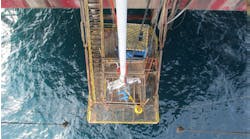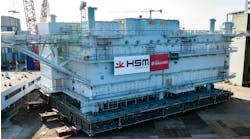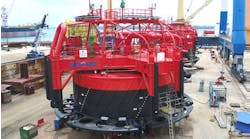With advancements in drilling technology have come equivalent advancements in the fluids used with this technology. Improved oil and synthetic based drilling fluids (muds) have been developed and are being used to drill wells in hostile environments where high pressures, high temperatures, thick shales, and shale sloughing are encountered. Both the risks and costs for these wells are high.
While the improved fluids have gained industry support for their efficiency and usefulness, they have also complicated the logging processes involved in collecting the data necessary to evaluate difficult drilling prospects. One of the challenges is from oil-based and other non-conductive muds used in drilling thin beds, shale, and low-resistive formations.
Evaluation challenges
The evaluation of thinly bedded formations poses unique challenges for the industry. Exactly what constitutes a thin bed is argued by petrophysicists, but a general definition might be any bed with a thickness that is less than the vertical resolution of the standard open hole log suite (e.g. a quad combo), which in most cases is between 1 and 2 ft. As the bedding thickness decreases, accurate reservoir characterization becomes increasingly difficult. In the limit of centimeter-thick bedding, detection of the reservoir is at risk.
Once “on bottom,” the six calipers arms are opened, the pads are energized, and the log is recorded in the up direction between 10 and 30 fpm, depending on borehole conditions.
A typical solution to the above problem is to augment the standard log suite with high vertical resolution electrical images. Some logging tools can generate electrical images with vertical resolution on the order of a tenth of an inch. When used in concert with the standard log suite, the electrical images facilitate a more complete characterization and evaluation of a thinly-bedded reservoir.
Common imaging applications include high vertical resolution pay zone volumetrics (both fluids and minerals), pay zone detection (in extreme thin bed /”low contrast” pay zones), structural and stratigraphic dips, sedimentary features and textures, and net-to-gross sand counts. Also, identification of faults and unconformities, evaluation of sedimentary sequences and flow units, lithologic unit thickness, secondary porosity evaluation, sequence stratigraphy analysis and borehole stresses analysis.
While electrical imaging technology has been available for 20 years and has seen certain advances in performance (e.g. dynamic range, borehole coverage), there has been one persistent limitation--the drilling mud must be electrically conductive. In virtually all water-based mud systems, this condition is satisfied. The electrical currents that comprise the images are able to easily pass between the imaging tool and the formation.
However, in oil-based mud (OBM) systems quite the opposite condition is present. Oil muds and mud cakes are virtually perfect insulators and current passage from conventional imaging tools to the formation is almost impossible. Clearly, a new type of sensor technology is required to satisfy the demand for electrical images in oil muds.
New imaging technology
After several years of research and development into OBM imaging, Halliburton recently introduced its Oil Mud Reservoir Imager (OMRI) to the industry. The tool uses sensor technology capable of electrical current generation in the formation without direct coupling to generate high resolution electrical images.
The OMRI tool is 27.54 ft in length, 5.5-in. in diameter, and can operate in a hole as small as 6.5-in. or as large as 16-in. diameter.
The tool has no dependency on mud conductivity, and the sensor performs in all types of oil mud systems, whether synthetic or natural. The tool retains the six-arm configuration of previous imaging tools to offer the same degree of borehole coverage. Each of the six arms is independent and each pad is articulated in two axes. This design helps the tool’s pads maintain positive contact with the formation wall an important factor for all wireline imaging technologies. Finally, a signal acquisition scheme is employed that electrically compensates for those cases where good pad contact cannot be maintained due to washouts, borehole rugosity, or other abnormalities.
Tool operation
Once “on bottom”, the six calipers arms are opened, the pads are energized, and the log is recorded in the up direction at between 10 and 30 fpm depending on borehole conditions.
Directly in front of each pad, voltages from about 3 in. into the formation are recorded by an array of receivers. These voltages are sensitive to the varying resistivities of the formation layers and have vertical resolution on the order of 1 in. Then they are transformed into micro resistivity curves which, in turn, are processed in real time to produce oriented color images.
Physically, the tool is 27.54 ft in length and 5.5 in. in diameter. It can operate in a hole as small as 6.5-in. or as large as 16-in. It weighs 760 lbs and is rated for operations at up to 350°F and 20,000 psi. Images are obtainable in mudcakes up to 0.25 in. thick and in formations with resistivities ranging from 0.5 to 10,000 ohm-m.
Since the industry is and will continue to pursue shallow and deepwater basins throughout the world using oil-based or non-conductive muds in thin beds, shale and low resistive formations, this technology eliminates these challenges. As a result, geologists can now pinpoint structural details and features such as faults and thin beds harboring hydrocarbons that otherwise would go undetected and unproduced.
The industry today has the opportunity to meet or exceed the demands of drilling in extreme environments where high pressures, high temperatures, shale sloughing, or thick shale formations under extreme stress are encountered.





